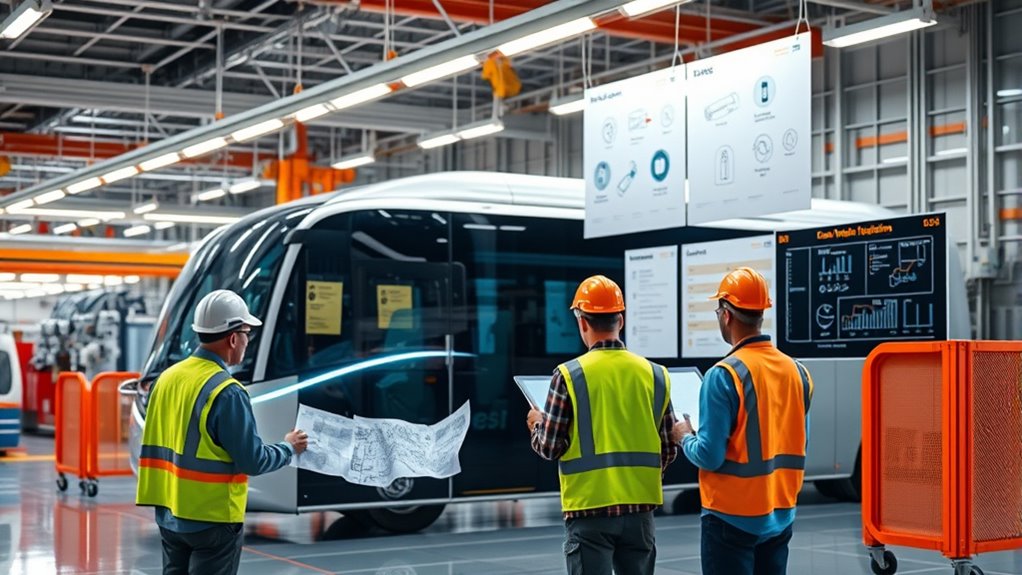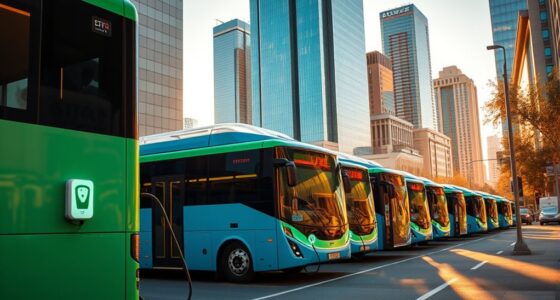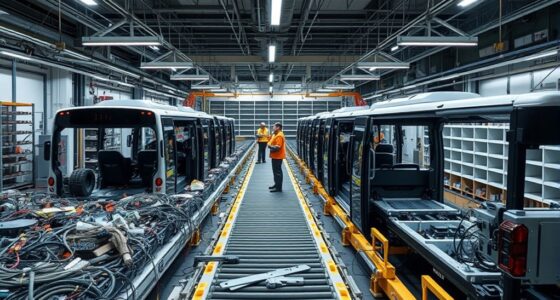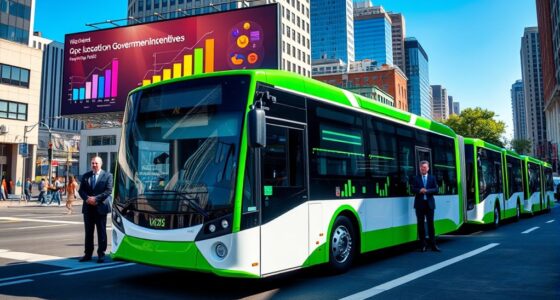New regulations are tightening safety standards, emission requirements, and offering incentives like tax credits that influence electric bus manufacturers’ strategies. Zero-emission mandates push firms to innovate and expand infrastructure, while compliance with safety certifications and technological standards increases costs. Governments also provide funding programs that make production more affordable. Staying ahead means adapting to evolving policies and embracing new technologies—if you keep exploring, you’ll uncover how these regulations shape the industry’s future.
Key Takeaways
- Stricter emission standards and zero-emission mandates are requiring electric bus manufacturers to meet enhanced environmental compliance.
- Safety certification requirements from agencies like the FTA demand rigorous testing of batteries and vehicle safety features.
- Regulations are expanding infrastructure standards, prompting manufacturers to develop compatible charging stations and ensure interoperability.
- Federal and state incentive programs influence compliance, with grants and subsidies guiding production targets and technology upgrades.
- Evolving standards for battery safety, fire resistance, and cybersecurity are increasing development and certification costs for manufacturers.
Regulatory Frameworks Driving Market Adoption
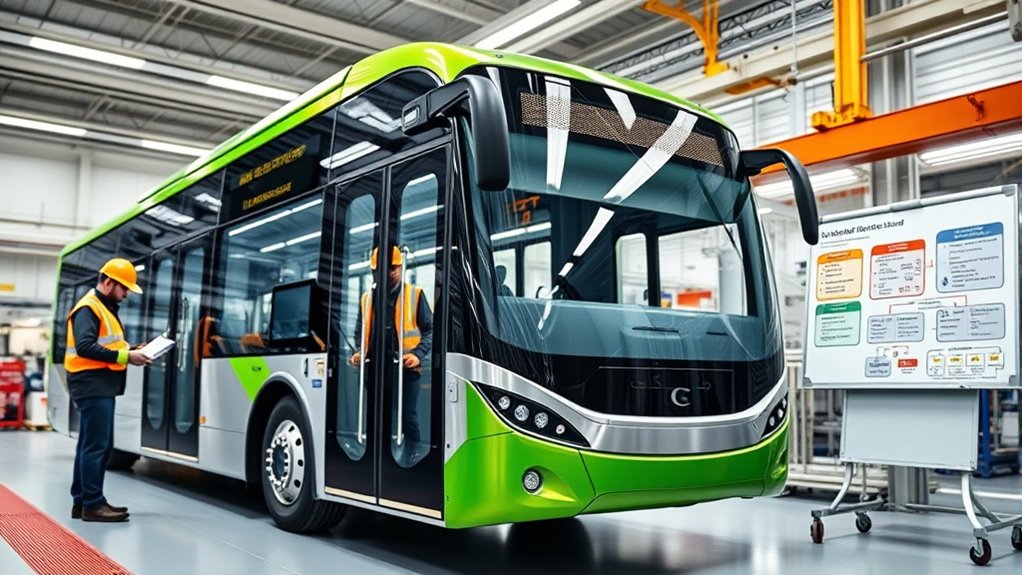
Regulatory frameworks play a crucial role in driving the adoption of electric buses by establishing clear standards and incentives. Stricter emission standards are pushing transit agencies toward electric options to meet environmental goals. Safety certifications from the Federal Transit Administration ensure electric buses comply with federal, state, and local safety rules. Cybersecurity vulnerabilities can pose additional challenges for electric bus infrastructure, emphasizing the need for secure systems. Government mandates for low-emission transportation further encourage fleets to switch to electric. Regulations also support infrastructure development, making charging stations more accessible and affordable. Industry best practices guide manufacturers in managing electric bus-specific hazards, boosting safety and reliability. These regulations promote environmental benefits, improved public health, and technological innovation. Additionally, fiscal incentives linked to compliance make electric buses more financially attractive, accelerating market growth and encouraging manufacturers to innovate and compete effectively. Market growth opportunities are further enhanced by evolving policies that support sustainable transportation solutions.
State and Federal Policy Initiatives Supporting Electrification
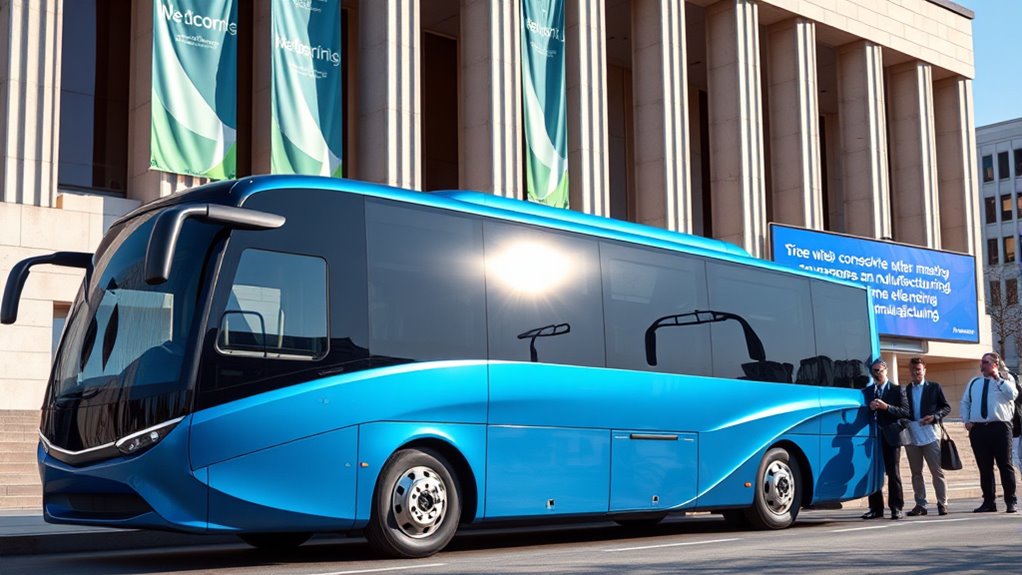
State and federal policy initiatives are pivotal drivers of electric bus adoption, providing essential funding, incentives, and collaborative support to accelerate the shift.
The federal Clean School Bus Program has funded over 80% of electric school buses, supporting 2,200 buses and playing a key role in equitable access nationwide. Early exposure to STEM can also foster a mindset of innovation and problem-solving among future transportation leaders.
State programs like California’s voucher incentives support thousands of electric buses, with half of the top funding sources originating from state efforts. These policy incentives significantly influence manufacturer investment decisions and market growth.
Additionally, Volkswagen settlement funds have backed projects in 28 states.
Partnerships between utilities and school districts further reduce costs and improve infrastructure.
These combined policies and collaborations create a strong market momentum, encouraging manufacturers to innovate and expand their electric offerings.
Innovations in AI technologies enhance music composition and data analysis are also influencing how industries adapt to new regulations and technological changes.
Together, federal and state initiatives are vital in shaping a sustainable, low-emission transportation future.
Impact of Zero-Emission Mandates on Manufacturer Strategies
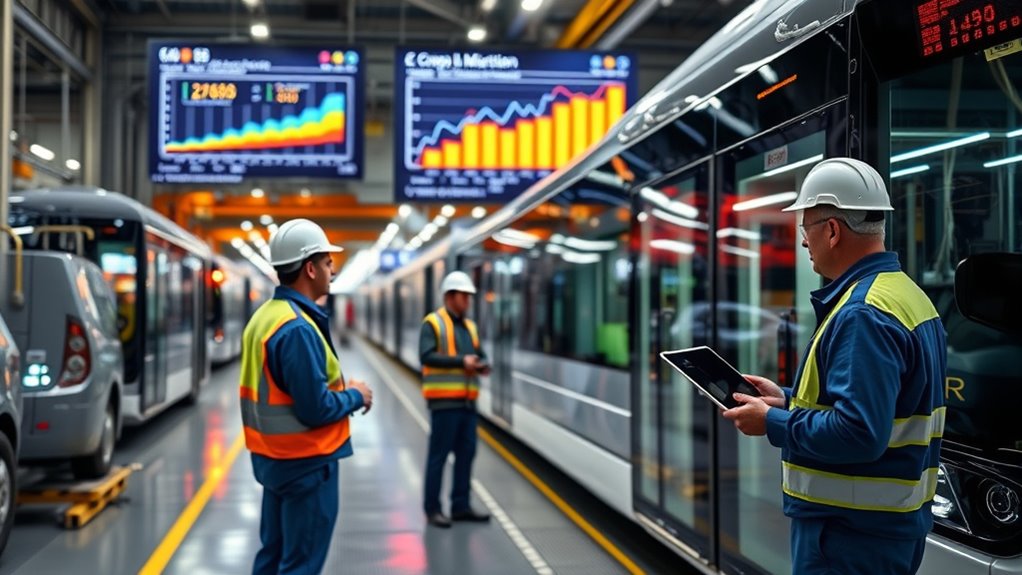
As policies push toward zero-emission fleets, manufacturers are adjusting their strategies to meet new mandates. You’re shifting production lines to focus on electric and hydrogen fuel-cell vehicles, aligning with regulatory targets. High costs of electric buses and batteries challenge profitability, prompting investments in R&D to improve efficiency and reduce expenses. You’re also modifying supply chains to secure batteries, electric motors, and other components. Meeting strict standards requires updating manufacturing processes and ensuring compliance. To support these changes, you’re investing in infrastructure, despite the significant upfront costs. The push for zero emissions expands market opportunities, but fierce competition for government grants and funding adds pressure. Ultimately, these mandates are reshaping your long-term planning, forcing you to innovate quickly while balancing costs and regulatory demands. Understanding tax implications can help you optimize your investment strategies in this transition.
Incentives and Tax Credits Shaping Production Costs
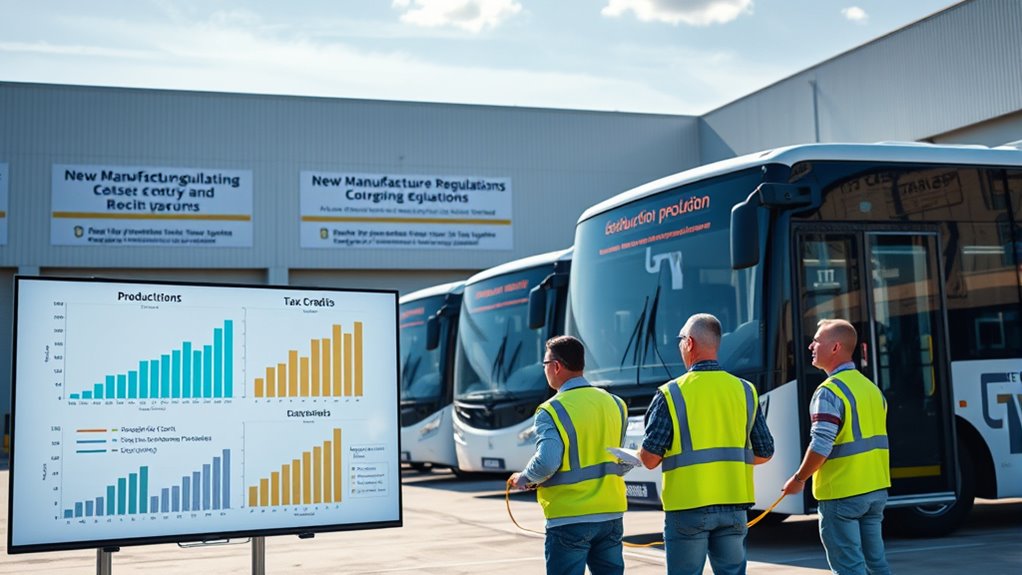
Incentives and tax credits play a crucial role in shaping production costs for electric bus manufacturers by making electric vehicles more financially attractive to buyers. Federal tax credits, such as up to $40,000 for heavy-duty buses over 14,000 pounds, markedly lower upfront purchase prices, boosting demand. Additionally, these incentives can influence the market adoption of electric buses by reducing financial barriers for operators. Tax credits for charging infrastructure, covering up to 30% of costs, help reduce system expenses, enabling smoother fleet transitions. The elective pay mechanism allows tax-exempt entities to access these credits easily. With no geographic restrictions, these incentives open markets nationwide. Qualified manufacturers like GreenPower benefit from increased sales, encouraging economies of scale that can lower production costs. Market expansion is further supported by the widespread availability of these incentives across different regions. Understanding sound design techniques can also improve the communication of technical information in industry reports and promotional materials. Additionally, clear communication about regulatory compliance requirements can help manufacturers navigate legal complexities more effectively.
Compliance Standards and Technological Requirements
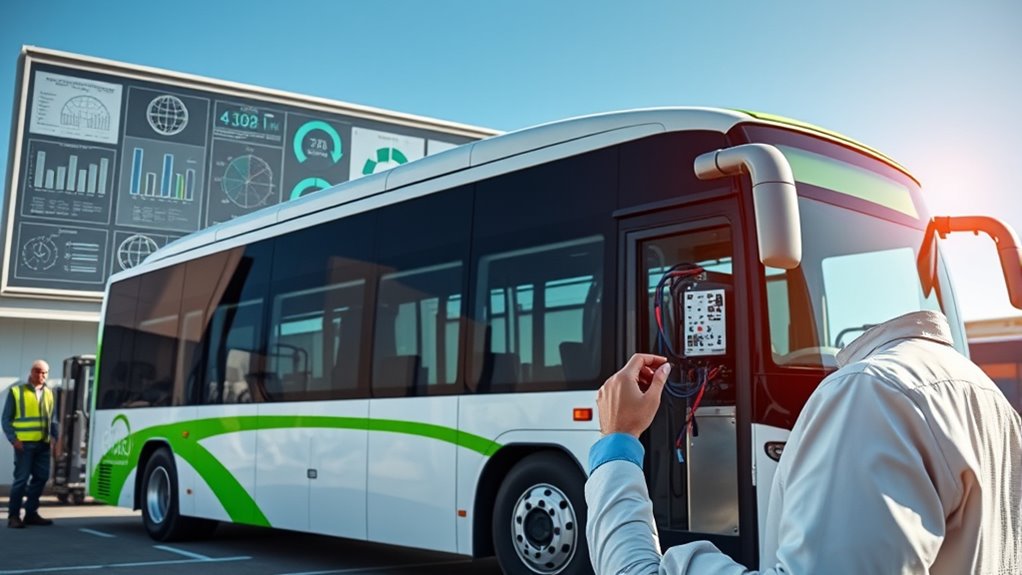
Regulatory standards and technological requirements shape how electric bus manufacturers develop and bring their vehicles to market. You must meet strict environmental regulations, especially in regions like Europe aiming for carbon neutrality by 2030-2040. Zero tailpipe emissions help you comply with global emission standards.
Safety is critical; battery safety and fire protection regulations must be met, and certifications obtained from regulatory bodies. Additionally, battery safety measures are essential to prevent incidents and ensure passenger safety in all operational conditions.
Technologically, advancements in battery tech improve range and efficiency, while robust charging infrastructure supports adoption. You need lightweight designs to boost energy efficiency and sophisticated software for real-time monitoring.
Ensuring supply chain resilience, scaling manufacturing capacity, and implementing rigorous quality controls are essential steps.
Finally, thorough testing—performance, safety, environmental—is mandatory, with certifications needed to enter markets successfully.
Market Growth Trends and Industry Response
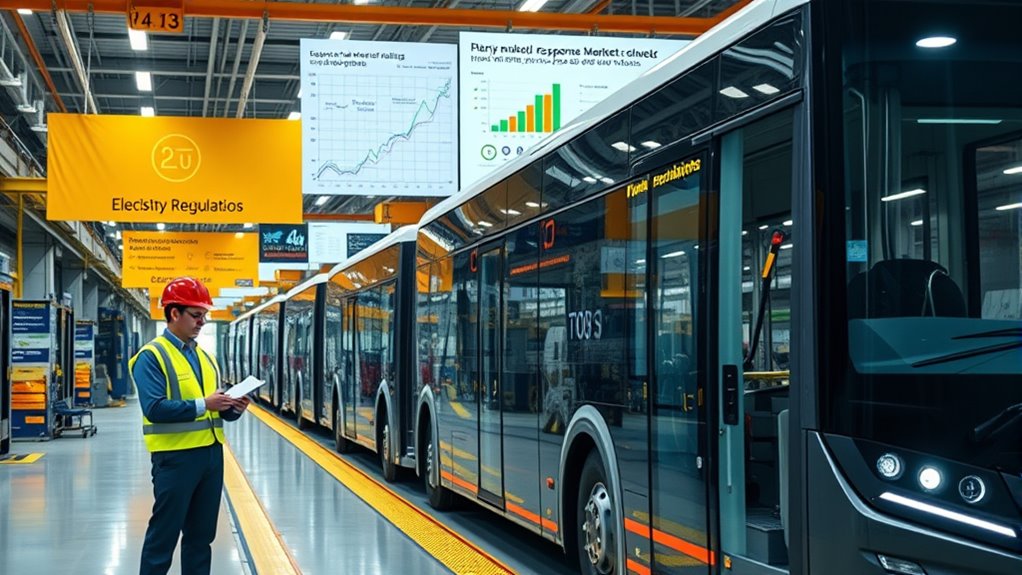
The electric bus market is experiencing rapid growth, driven by rising demand and technological advancements. Globally, the market is projected to reach $37.5 billion or more by 2030, with unit sales expected to hit over 1 million by 2032 at an 18.2% CAGR.
The electric bus market is booming, projected to surpass $37.5 billion by 2030 with over 1 million units sold by 2032.
Asia Pacific dominates with 98.39% market share, mainly due to mass production and competitive pricing from companies like BYD and Yutong. Low light office plants are being considered by some manufacturers to improve employee well-being at production facilities.
North America shows the highest regional growth, while Europe’s e-bus registrations grow at 53% annually. Best Restaurants in the region are also increasingly adopting sustainable practices, reflecting a broader commitment to environmental responsibility.
Industry responses include investments in battery tech, charging infrastructure, and localized manufacturing.
Governments’ zero-emission mandates and incentives accelerate adoption, while partnerships and innovative financing options help manufacturers meet rising demand efficiently.
Additionally, the industry is focusing on battery longevity improvements to ensure longer-lasting and more reliable electric buses, which is crucial for reducing total ownership costs and enhancing consumer confidence.
Strategic Opportunities and Challenges for Manufacturers
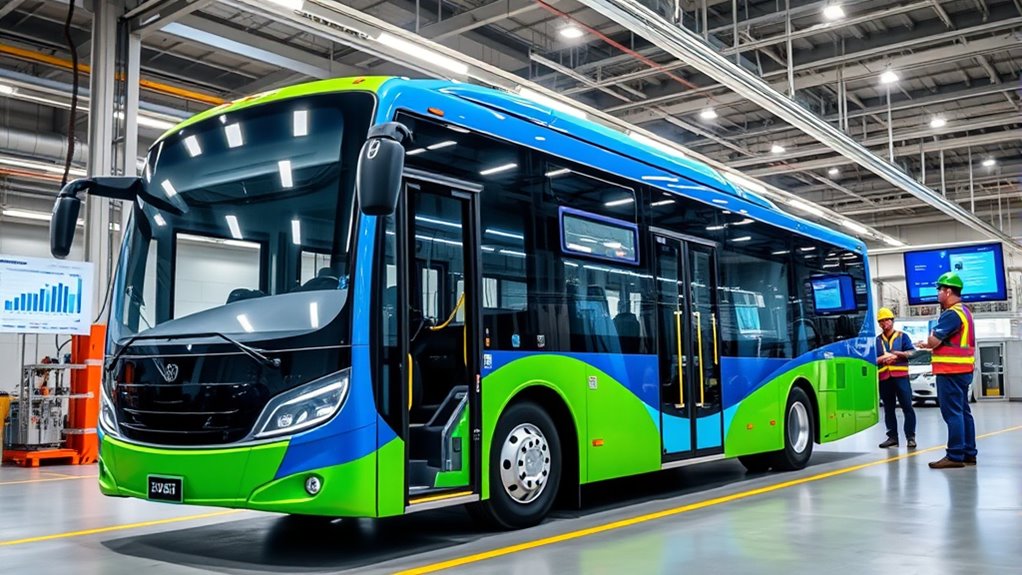
Electric bus manufacturers have a unique opportunity to expand their market share by forming strategic partnerships with technology firms and energy providers. These collaborations can boost innovation, improve efficiency, and streamline infrastructure development. Additionally, staying vigilant about emerging AI safety measures can help ensure that new technologies are implemented responsibly and securely. You can also tap into government incentives like grants and funding programs, which support the shift to zero-emission fleets. Advancements in battery tech and lightweight materials open new market possibilities, allowing you to offer buses with longer range and better performance. Moreover, integrating Cultural Intelligence into your strategic planning can facilitate better collaboration with international partners and adapt your marketing to diverse customer bases. Understanding essential oils for respiratory health can also inspire eco-friendly interior enhancements that improve passenger comfort and well-being. Developing a comprehensive relationship management strategy can foster stronger partnerships and customer loyalty. However, challenges remain—compliance costs, supply chain vulnerabilities, and the need for extensive charging infrastructure can strain resources. Increased market competition and the push for standardization also demand agility. To succeed, you must balance leveraging opportunities with managing these obstacles, ensuring your products meet evolving regulations and customer expectations.
Frequently Asked Questions
How Do Future Regulations Impact Electric Bus Pricing Strategies?
Future regulations influence your electric bus pricing strategies by increasing compliance costs initially. They also promote innovation and technological advancements that can lower long-term costs.
You might see higher prices at first, but government incentives and economies of scale will help reduce expenses over time.
As regulations push for efficiency and sustainability, you’ll need to balance upfront costs with the benefits of lower operational expenses and market demand growth.
What Are the Main Barriers to Compliance for Small Manufacturers?
You face several barriers to compliance as a small manufacturer. You struggle with high upfront costs for compliant components and infrastructure, making it tough to keep pace with larger competitors.
Testing expenses and raw material volatility add financial pressure. Additionally, managing complex safety certifications and regulatory requirements demands time and expertise you might lack.
Limited market data and infrastructure gaps further hinder your ability to adapt quickly and scale efficiently.
How Will Regulations Influence Battery Technology Development?
Regulations push you to innovate faster in battery tech by demanding higher safety standards, like thermal runaway prevention and fire suppression. You’ll need to invest in advanced BMS, materials, and testing to meet certification requirements.
This accelerates the adoption of solid-state batteries and fast-charging solutions, making your products safer and more efficient. While it increases costs upfront, it ultimately drives you to develop better, more reliable batteries that comply with evolving global standards.
Are There Regional Differences in Regulatory Requirements?
You might think regional differences are small, but they shape the entire electric bus industry!
In the U.S., federal and state policies vary widely, affecting incentives and compliance rules.
Meanwhile, the EU might be more open, welcoming international suppliers.
Asia-Pacific, led by China, dominates deployment with favorable policies.
These regional variations directly influence your strategies, partnerships, and success in deploying electric buses across different markets.
How Might Policy Changes Affect Long-Term Industry Competitiveness?
You should recognize that policy changes can substantially impact your long-term competitiveness by shaping market demand, compliance costs, and innovation incentives.
Stricter emission standards and government mandates push you to accelerate R&D, adopt advanced technologies, and expand manufacturing capacity.
Staying adaptable and proactive in responding to evolving regulations gives you an edge, helping you maintain market share, reduce costs, and capitalize on subsidies and incentives that support sustainable growth.
Conclusion
As you navigate these new regulations, think of yourself as a captain steering through changing tides. Just like a sailor adjusts sails to catch the wind, manufacturers must adapt to evolving standards and incentives. With the market expected to grow by over 20% annually, embracing innovation and compliance becomes your compass. Staying ahead means mastering these currents—turn challenges into opportunities, and you’ll steer your business toward a promising horizon.
